HC3031 Trends in Global Business: Decision-Making Biases Report
VerifiedAdded on 2022/12/27
|12
|940
|82
Report
AI Summary
This report delves into the realm of decision-making biases, exploring how cognitive shortcuts and flawed perceptions can influence choices. It begins by defining decision-making and highlighting the deviations that can occur. The report identifies common biases, such as confirmation bias, framing effect, survivorship bias, the IKEA effect, anchoring bias, overconfidence bias, planning fallacy, availability heuristic, and progress bias. Each bias is explained with examples. Furthermore, the report offers practical strategies to mitigate these biases, emphasizing the importance of self-awareness, critical thinking, and seeking diverse perspectives to improve the quality of decisions. The conclusion reinforces the need for constant vigilance and a commitment to challenging biases for better decision-making.
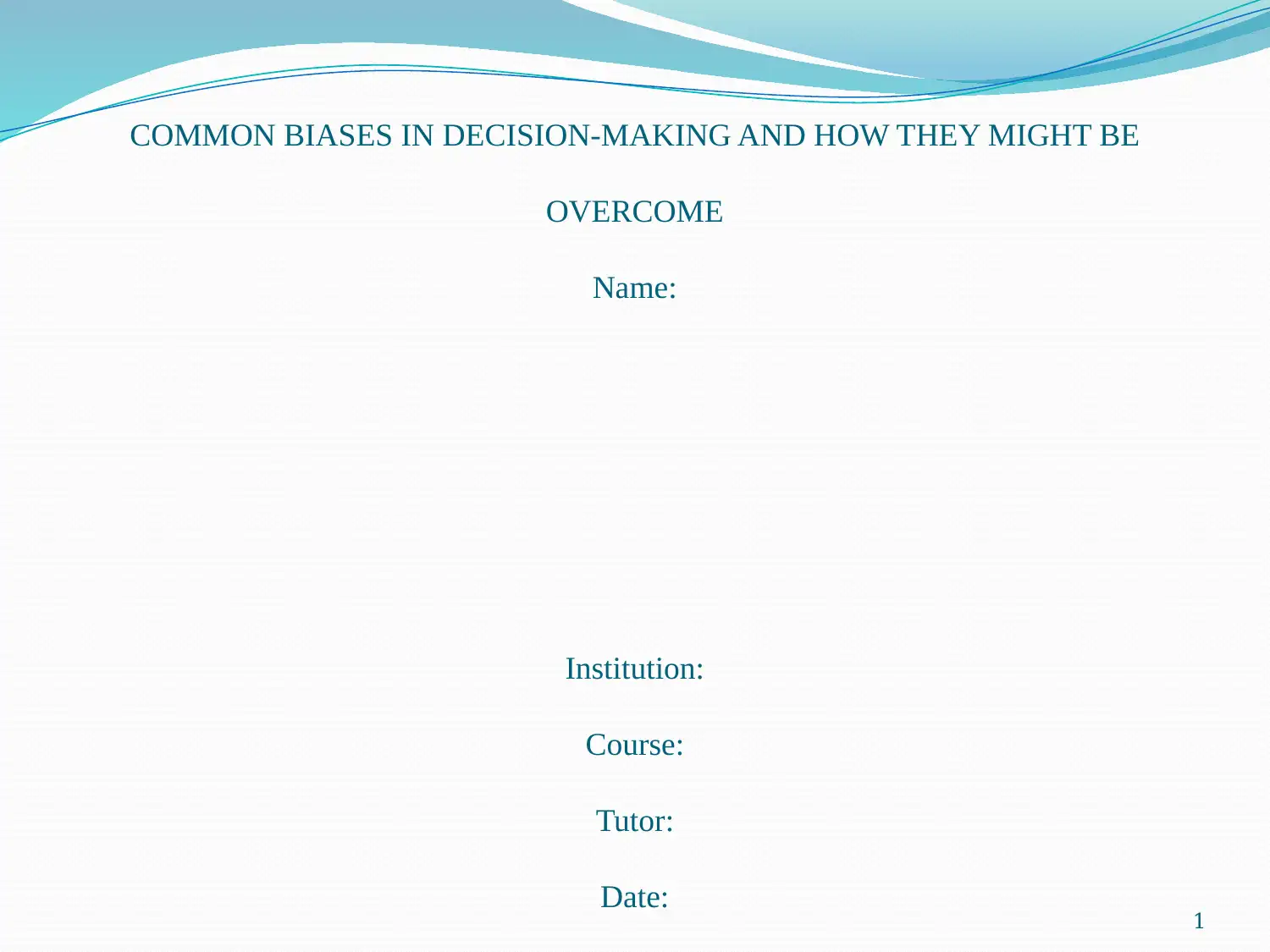
1
COMMON BIASES IN DECISION-MAKING AND HOW THEY MIGHT BE
OVERCOME
Name:
Institution:
Course:
Tutor:
Date:
COMMON BIASES IN DECISION-MAKING AND HOW THEY MIGHT BE
OVERCOME
Name:
Institution:
Course:
Tutor:
Date:
Paraphrase This Document
Need a fresh take? Get an instant paraphrase of this document with our AI Paraphraser
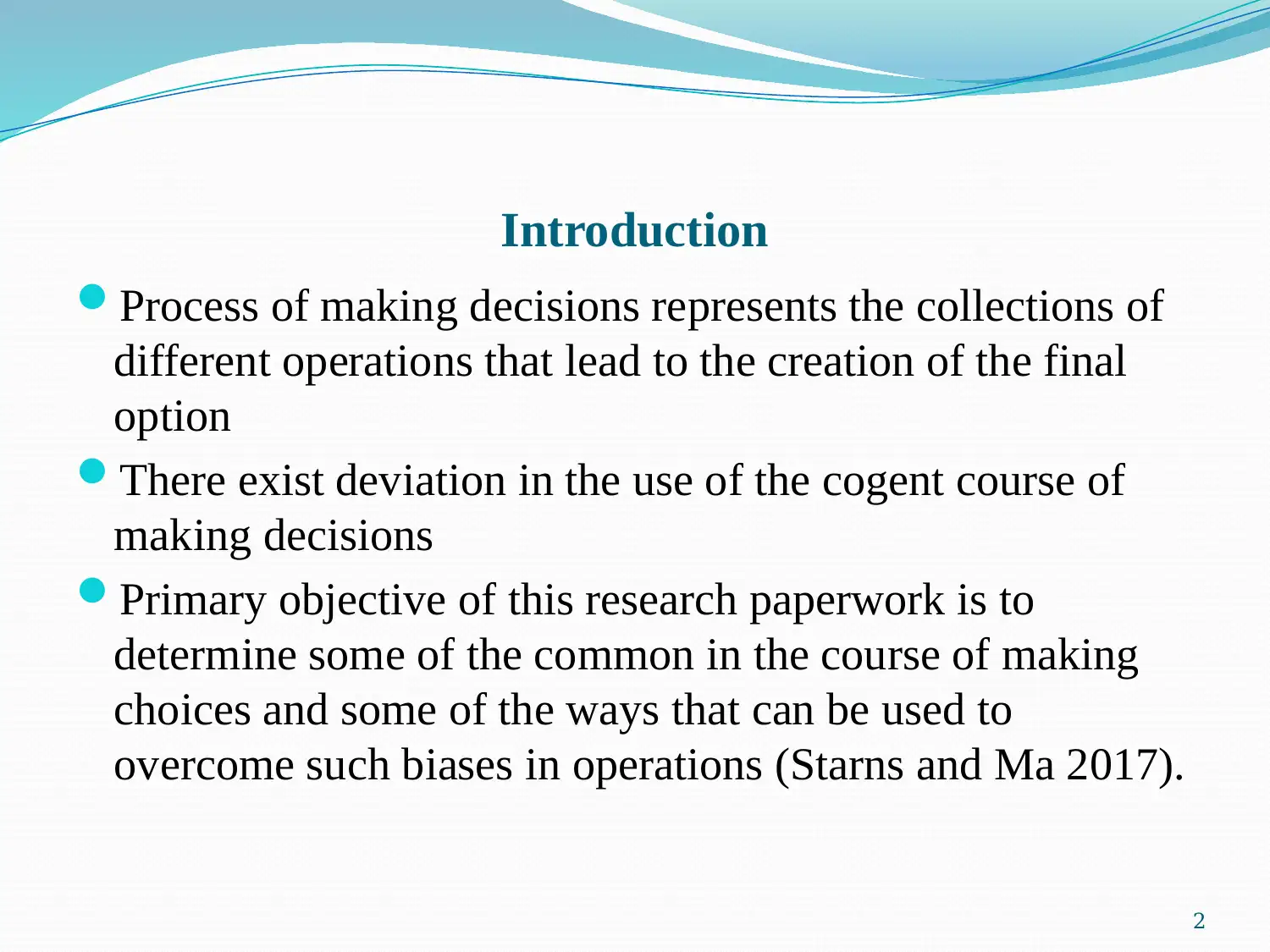
2
Introduction
Process of making decisions represents the collections of
different operations that lead to the creation of the final
option
There exist deviation in the use of the cogent course of
making decisions
Primary objective of this research paperwork is to
determine some of the common in the course of making
choices and some of the ways that can be used to
overcome such biases in operations (Starns and Ma 2017).
Introduction
Process of making decisions represents the collections of
different operations that lead to the creation of the final
option
There exist deviation in the use of the cogent course of
making decisions
Primary objective of this research paperwork is to
determine some of the common in the course of making
choices and some of the ways that can be used to
overcome such biases in operations (Starns and Ma 2017).
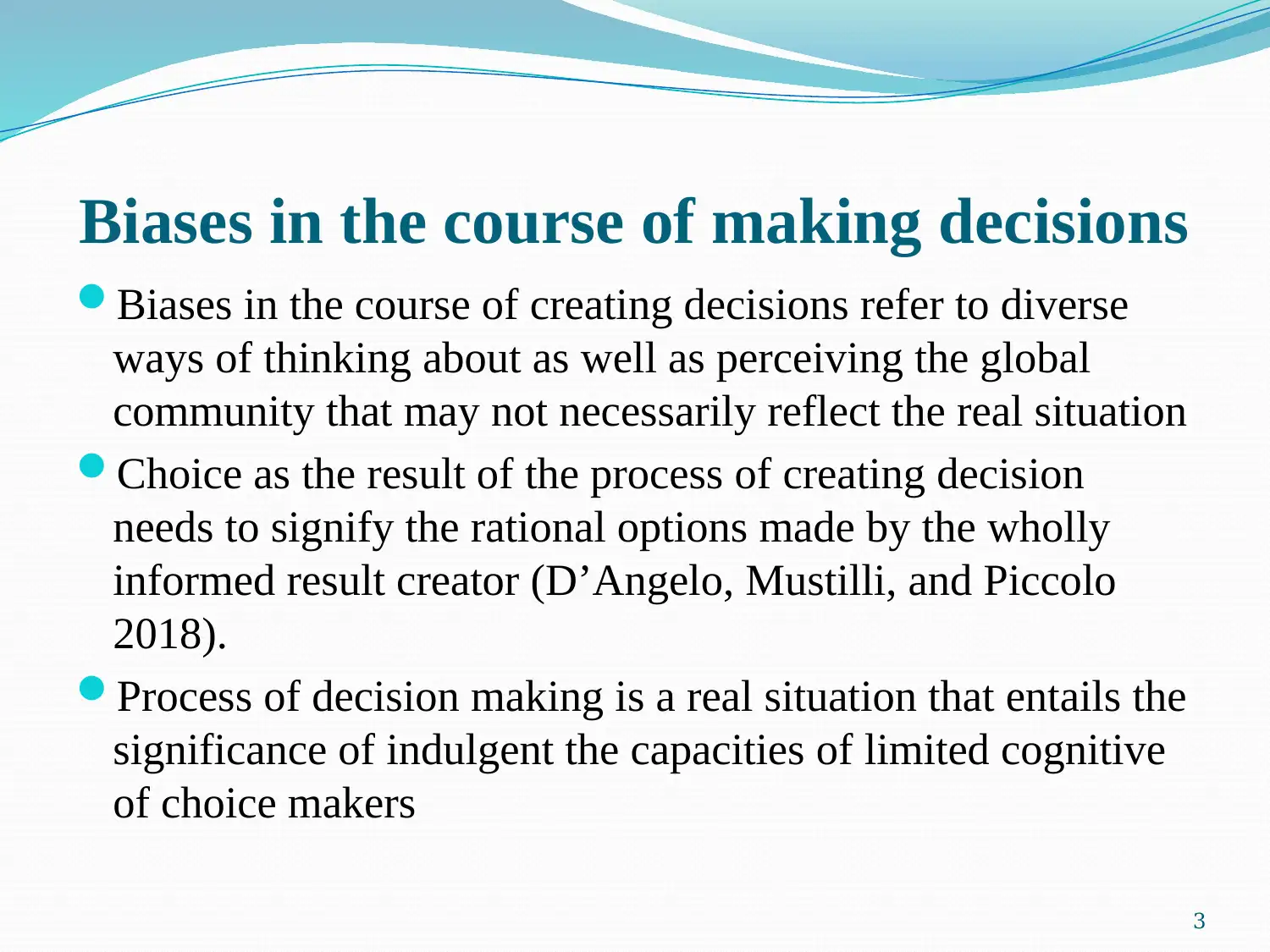
3
Biases in the course of making decisions
Biases in the course of creating decisions refer to diverse
ways of thinking about as well as perceiving the global
community that may not necessarily reflect the real situation
Choice as the result of the process of creating decision
needs to signify the rational options made by the wholly
informed result creator (D’Angelo, Mustilli, and Piccolo
2018).
Process of decision making is a real situation that entails the
significance of indulgent the capacities of limited cognitive
of choice makers
Biases in the course of making decisions
Biases in the course of creating decisions refer to diverse
ways of thinking about as well as perceiving the global
community that may not necessarily reflect the real situation
Choice as the result of the process of creating decision
needs to signify the rational options made by the wholly
informed result creator (D’Angelo, Mustilli, and Piccolo
2018).
Process of decision making is a real situation that entails the
significance of indulgent the capacities of limited cognitive
of choice makers
⊘ This is a preview!⊘
Do you want full access?
Subscribe today to unlock all pages.

Trusted by 1+ million students worldwide
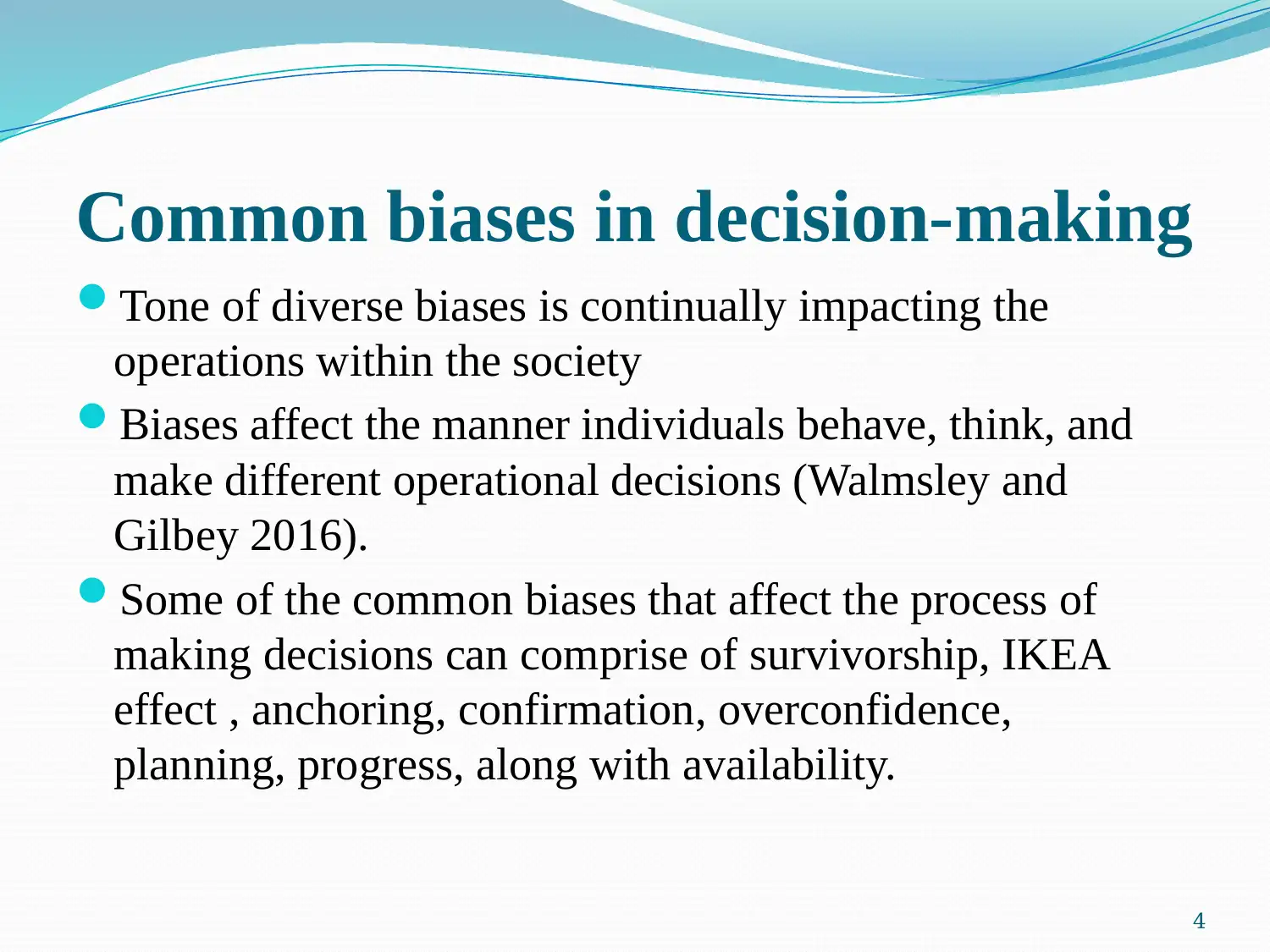
4
Common biases in decision-making
Tone of diverse biases is continually impacting the
operations within the society
Biases affect the manner individuals behave, think, and
make different operational decisions (Walmsley and
Gilbey 2016).
Some of the common biases that affect the process of
making decisions can comprise of survivorship, IKEA
effect , anchoring, confirmation, overconfidence,
planning, progress, along with availability.
Common biases in decision-making
Tone of diverse biases is continually impacting the
operations within the society
Biases affect the manner individuals behave, think, and
make different operational decisions (Walmsley and
Gilbey 2016).
Some of the common biases that affect the process of
making decisions can comprise of survivorship, IKEA
effect , anchoring, confirmation, overconfidence,
planning, progress, along with availability.
Paraphrase This Document
Need a fresh take? Get an instant paraphrase of this document with our AI Paraphraser
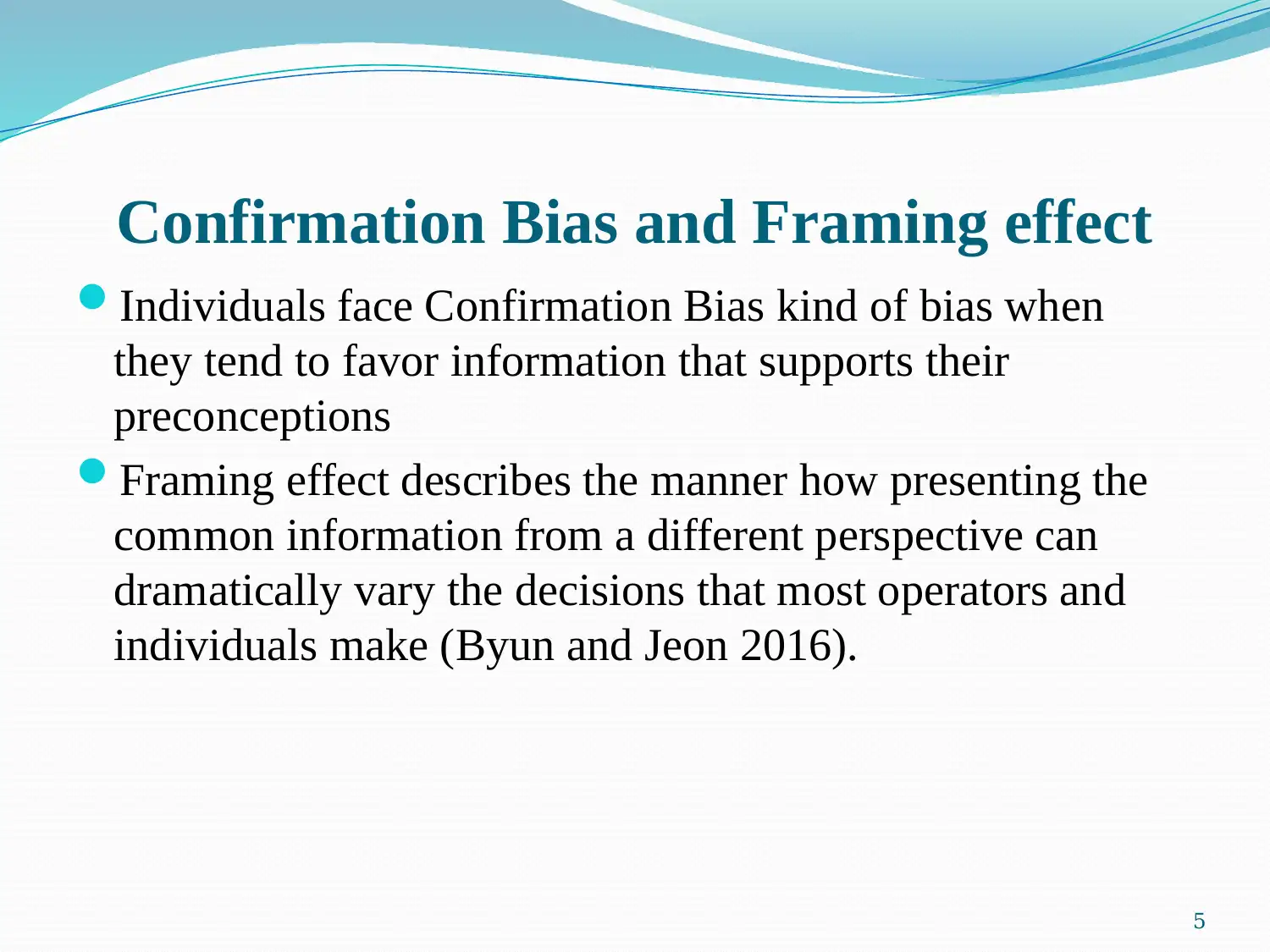
5
Confirmation Bias and Framing effect
Individuals face Confirmation Bias kind of bias when
they tend to favor information that supports their
preconceptions
Framing effect describes the manner how presenting the
common information from a different perspective can
dramatically vary the decisions that most operators and
individuals make (Byun and Jeon 2016).
Confirmation Bias and Framing effect
Individuals face Confirmation Bias kind of bias when
they tend to favor information that supports their
preconceptions
Framing effect describes the manner how presenting the
common information from a different perspective can
dramatically vary the decisions that most operators and
individuals make (Byun and Jeon 2016).
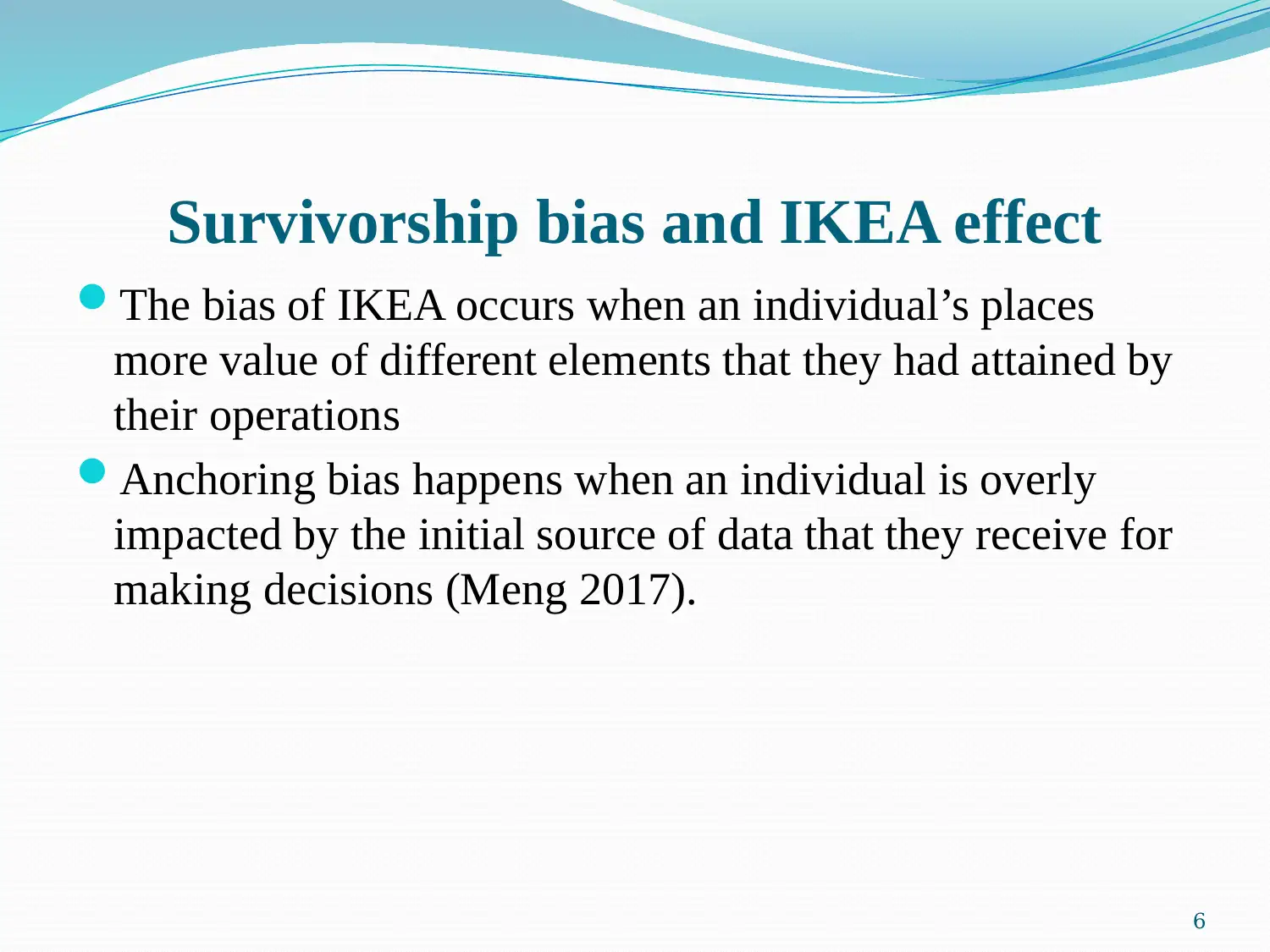
6
Survivorship bias and IKEA effect
The bias of IKEA occurs when an individual’s places
more value of different elements that they had attained by
their operations
Anchoring bias happens when an individual is overly
impacted by the initial source of data that they receive for
making decisions (Meng 2017).
Survivorship bias and IKEA effect
The bias of IKEA occurs when an individual’s places
more value of different elements that they had attained by
their operations
Anchoring bias happens when an individual is overly
impacted by the initial source of data that they receive for
making decisions (Meng 2017).
⊘ This is a preview!⊘
Do you want full access?
Subscribe today to unlock all pages.

Trusted by 1+ million students worldwide
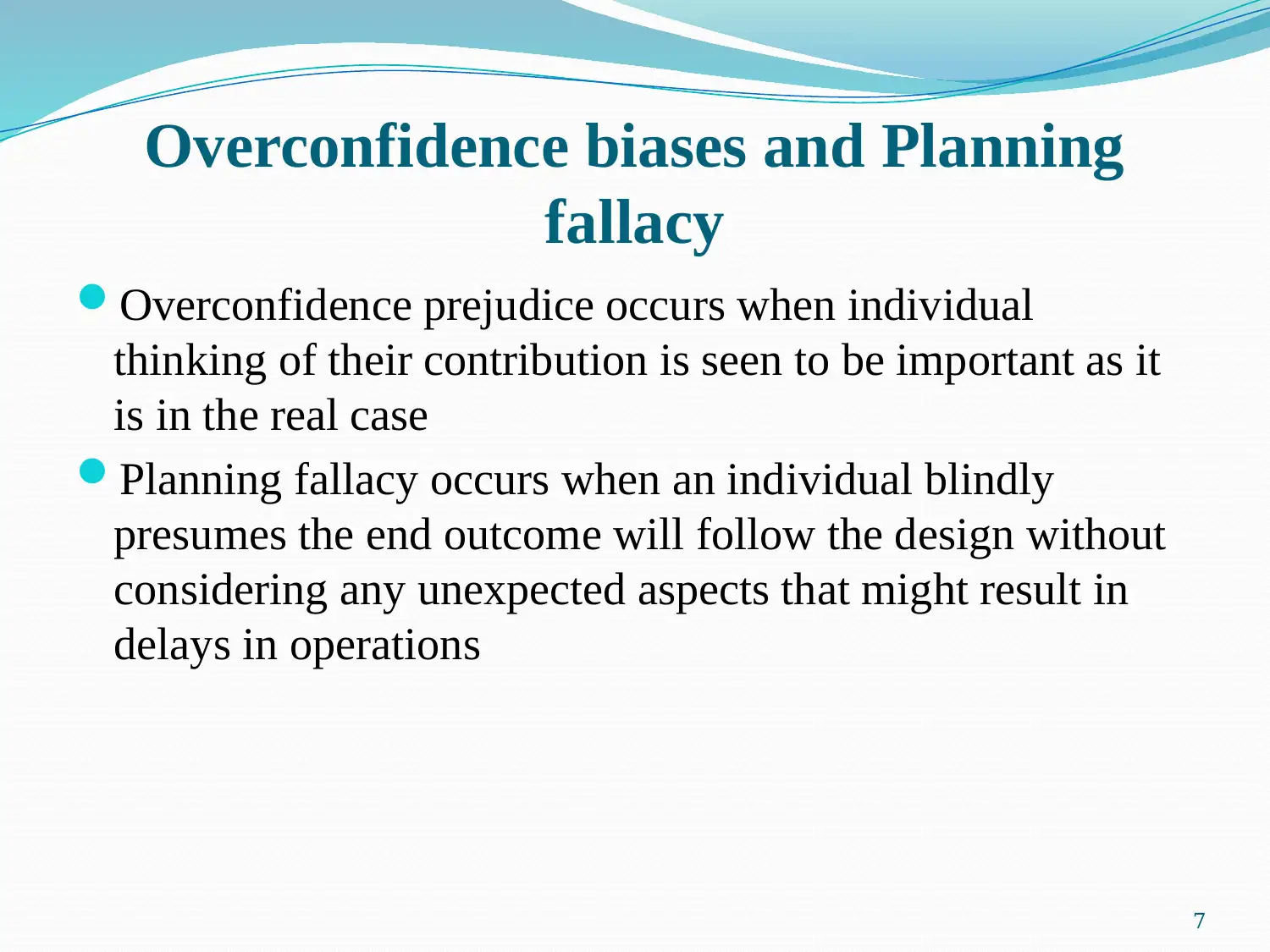
7
Overconfidence biases and Planning
fallacy
Overconfidence prejudice occurs when individual
thinking of their contribution is seen to be important as it
is in the real case
Planning fallacy occurs when an individual blindly
presumes the end outcome will follow the design without
considering any unexpected aspects that might result in
delays in operations
Overconfidence biases and Planning
fallacy
Overconfidence prejudice occurs when individual
thinking of their contribution is seen to be important as it
is in the real case
Planning fallacy occurs when an individual blindly
presumes the end outcome will follow the design without
considering any unexpected aspects that might result in
delays in operations
Paraphrase This Document
Need a fresh take? Get an instant paraphrase of this document with our AI Paraphraser
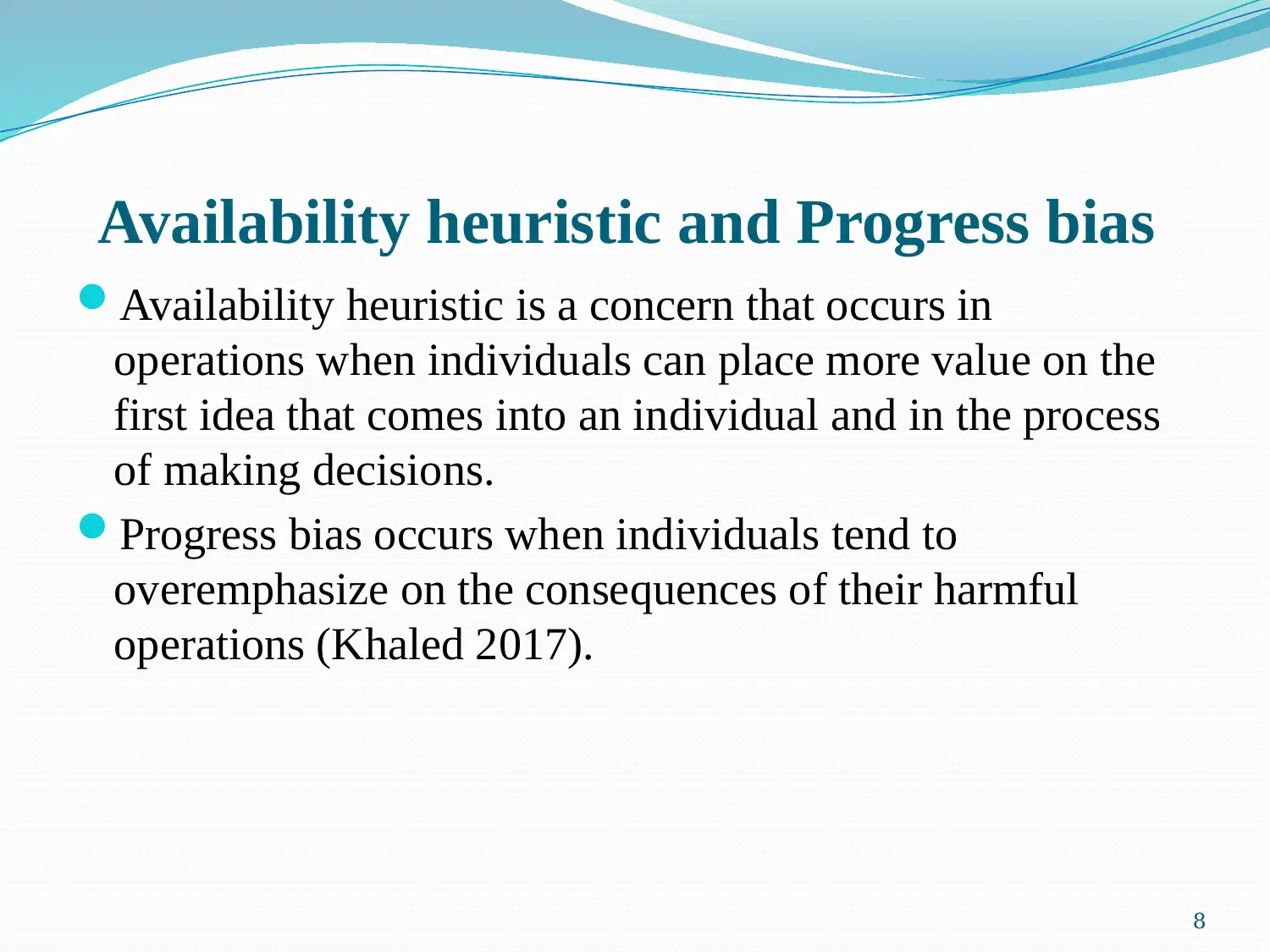
8
Availability heuristic and Progress bias
Availability heuristic is a concern that occurs in
operations when individuals can place more value on the
first idea that comes into an individual and in the process
of making decisions.
Progress bias occurs when individuals tend to
overemphasize on the consequences of their harmful
operations (Khaled 2017).
Availability heuristic and Progress bias
Availability heuristic is a concern that occurs in
operations when individuals can place more value on the
first idea that comes into an individual and in the process
of making decisions.
Progress bias occurs when individuals tend to
overemphasize on the consequences of their harmful
operations (Khaled 2017).
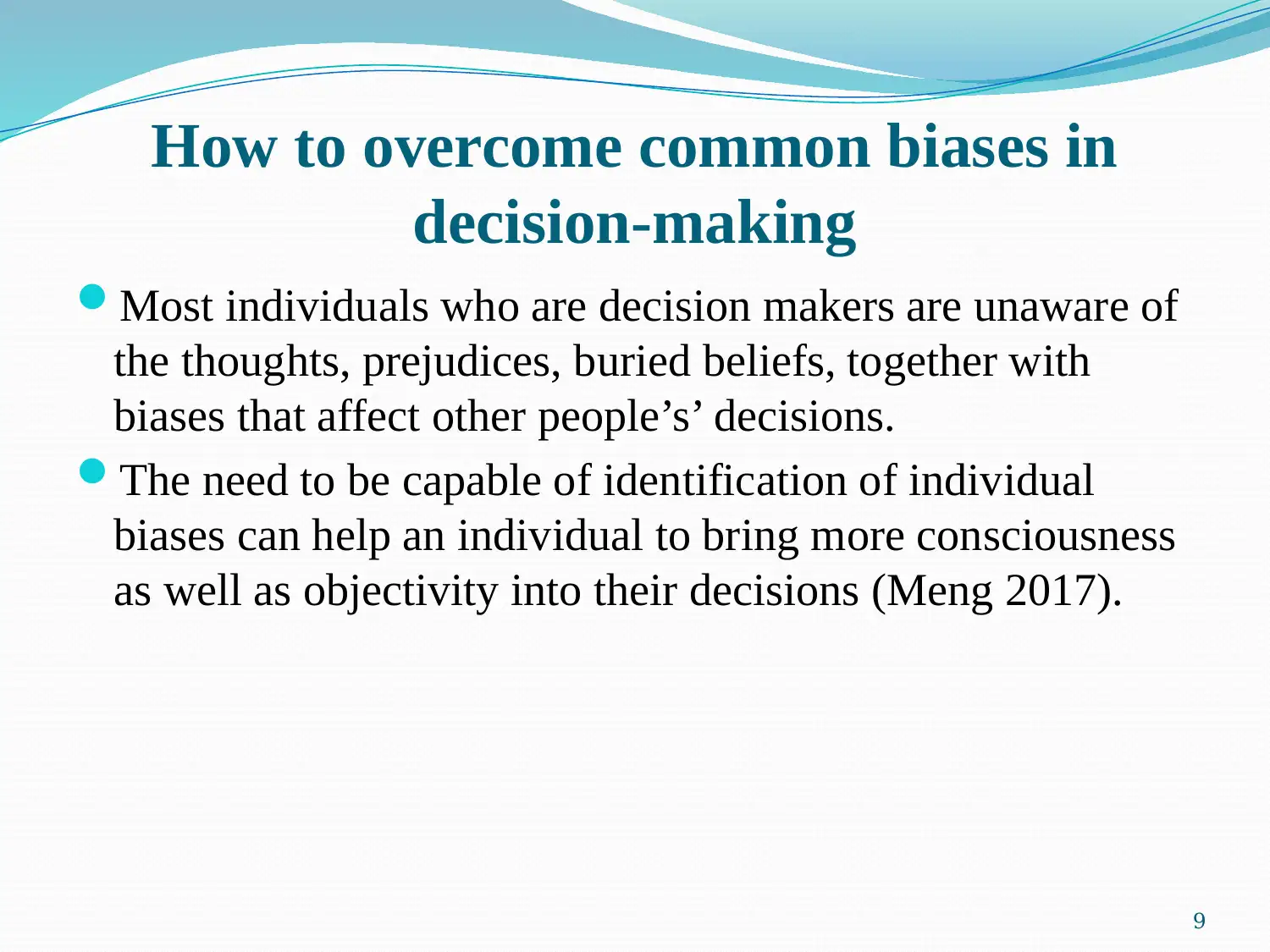
9
How to overcome common biases in
decision-making
Most individuals who are decision makers are unaware of
the thoughts, prejudices, buried beliefs, together with
biases that affect other people’s’ decisions.
The need to be capable of identification of individual
biases can help an individual to bring more consciousness
as well as objectivity into their decisions (Meng 2017).
How to overcome common biases in
decision-making
Most individuals who are decision makers are unaware of
the thoughts, prejudices, buried beliefs, together with
biases that affect other people’s’ decisions.
The need to be capable of identification of individual
biases can help an individual to bring more consciousness
as well as objectivity into their decisions (Meng 2017).
⊘ This is a preview!⊘
Do you want full access?
Subscribe today to unlock all pages.

Trusted by 1+ million students worldwide
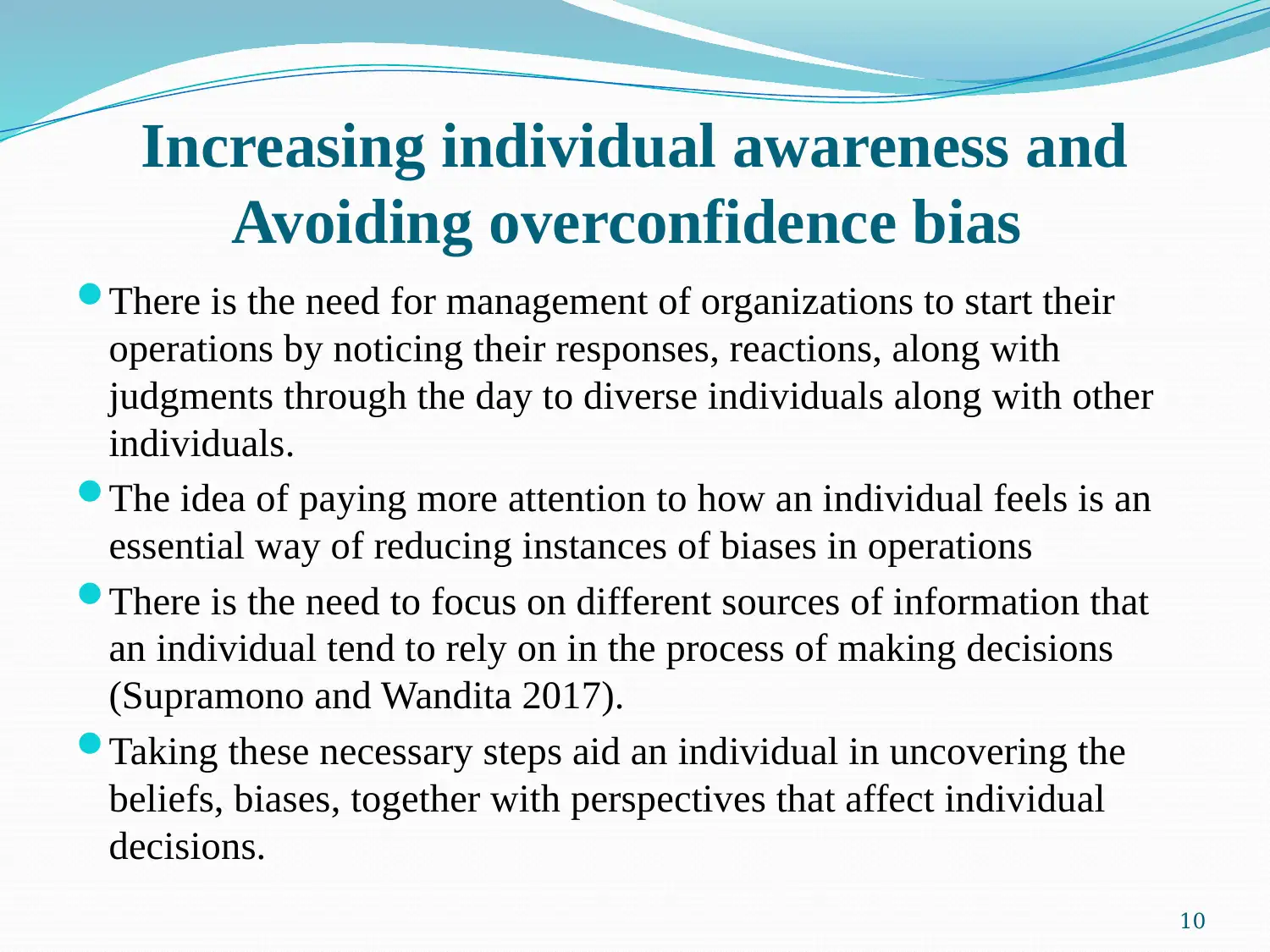
10
Increasing individual awareness and
Avoiding overconfidence bias
There is the need for management of organizations to start their
operations by noticing their responses, reactions, along with
judgments through the day to diverse individuals along with other
individuals.
The idea of paying more attention to how an individual feels is an
essential way of reducing instances of biases in operations
There is the need to focus on different sources of information that
an individual tend to rely on in the process of making decisions
(Supramono and Wandita 2017).
Taking these necessary steps aid an individual in uncovering the
beliefs, biases, together with perspectives that affect individual
decisions.
Increasing individual awareness and
Avoiding overconfidence bias
There is the need for management of organizations to start their
operations by noticing their responses, reactions, along with
judgments through the day to diverse individuals along with other
individuals.
The idea of paying more attention to how an individual feels is an
essential way of reducing instances of biases in operations
There is the need to focus on different sources of information that
an individual tend to rely on in the process of making decisions
(Supramono and Wandita 2017).
Taking these necessary steps aid an individual in uncovering the
beliefs, biases, together with perspectives that affect individual
decisions.
Paraphrase This Document
Need a fresh take? Get an instant paraphrase of this document with our AI Paraphraser
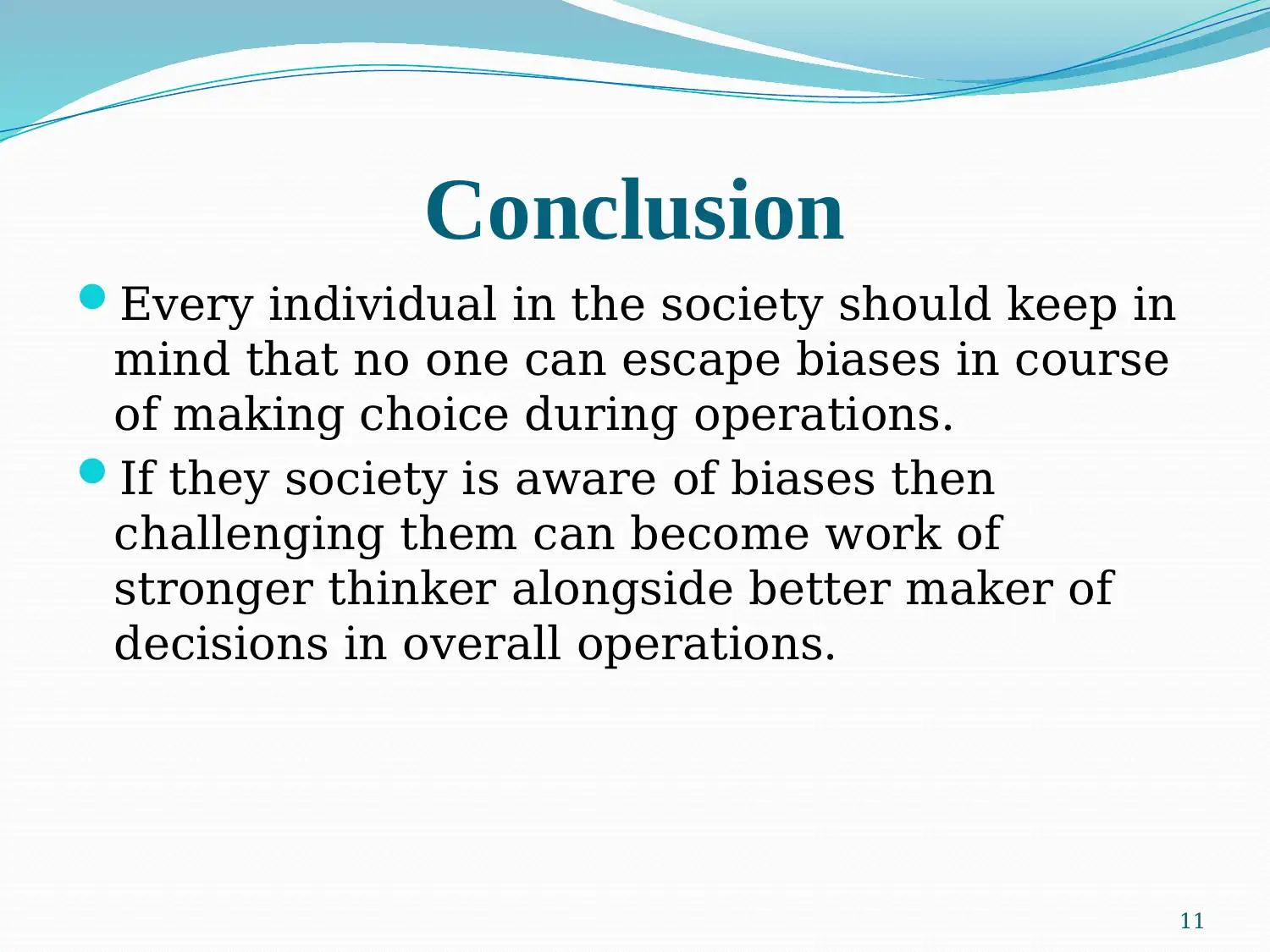
11
Conclusion
Every individual in the society should keep in
mind that no one can escape biases in course
of making choice during operations.
If they society is aware of biases then
challenging them can become work of
stronger thinker alongside better maker of
decisions in overall operations.
Conclusion
Every individual in the society should keep in
mind that no one can escape biases in course
of making choice during operations.
If they society is aware of biases then
challenging them can become work of
stronger thinker alongside better maker of
decisions in overall operations.
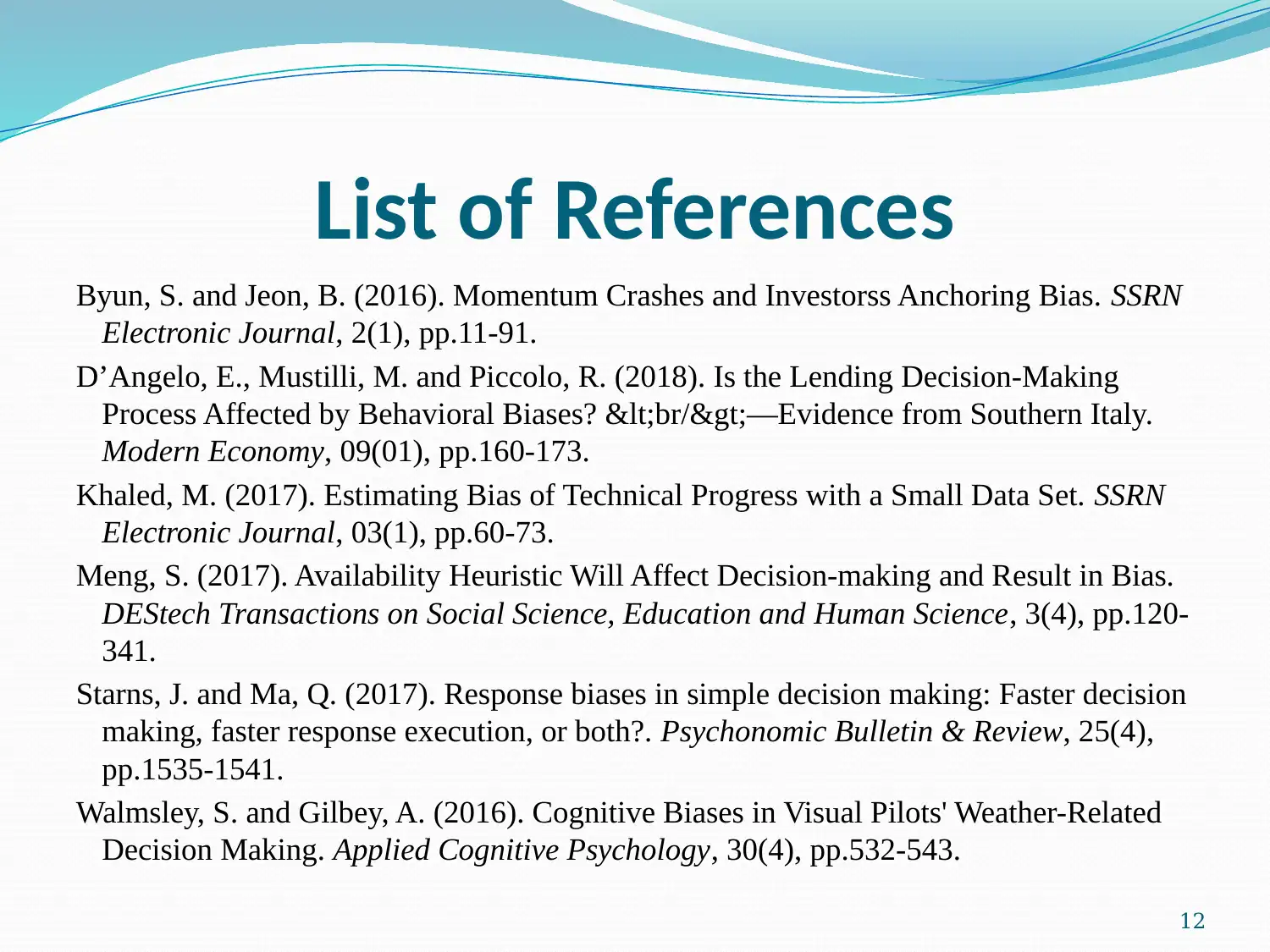
12
List of References
Byun, S. and Jeon, B. (2016). Momentum Crashes and Investorss Anchoring Bias. SSRN
Electronic Journal, 2(1), pp.11-91.
D’Angelo, E., Mustilli, M. and Piccolo, R. (2018). Is the Lending Decision-Making
Process Affected by Behavioral Biases? <br/>—Evidence from Southern Italy.
Modern Economy, 09(01), pp.160-173.
Khaled, M. (2017). Estimating Bias of Technical Progress with a Small Data Set. SSRN
Electronic Journal, 03(1), pp.60-73.
Meng, S. (2017). Availability Heuristic Will Affect Decision-making and Result in Bias.
DEStech Transactions on Social Science, Education and Human Science, 3(4), pp.120-
341.
Starns, J. and Ma, Q. (2017). Response biases in simple decision making: Faster decision
making, faster response execution, or both?. Psychonomic Bulletin & Review, 25(4),
pp.1535-1541.
Walmsley, S. and Gilbey, A. (2016). Cognitive Biases in Visual Pilots' Weather-Related
Decision Making. Applied Cognitive Psychology, 30(4), pp.532-543.
List of References
Byun, S. and Jeon, B. (2016). Momentum Crashes and Investorss Anchoring Bias. SSRN
Electronic Journal, 2(1), pp.11-91.
D’Angelo, E., Mustilli, M. and Piccolo, R. (2018). Is the Lending Decision-Making
Process Affected by Behavioral Biases? <br/>—Evidence from Southern Italy.
Modern Economy, 09(01), pp.160-173.
Khaled, M. (2017). Estimating Bias of Technical Progress with a Small Data Set. SSRN
Electronic Journal, 03(1), pp.60-73.
Meng, S. (2017). Availability Heuristic Will Affect Decision-making and Result in Bias.
DEStech Transactions on Social Science, Education and Human Science, 3(4), pp.120-
341.
Starns, J. and Ma, Q. (2017). Response biases in simple decision making: Faster decision
making, faster response execution, or both?. Psychonomic Bulletin & Review, 25(4),
pp.1535-1541.
Walmsley, S. and Gilbey, A. (2016). Cognitive Biases in Visual Pilots' Weather-Related
Decision Making. Applied Cognitive Psychology, 30(4), pp.532-543.
⊘ This is a preview!⊘
Do you want full access?
Subscribe today to unlock all pages.

Trusted by 1+ million students worldwide
1 out of 12
Related Documents
Your All-in-One AI-Powered Toolkit for Academic Success.
+13062052269
info@desklib.com
Available 24*7 on WhatsApp / Email
![[object Object]](/_next/static/media/star-bottom.7253800d.svg)
Unlock your academic potential
Copyright © 2020–2025 A2Z Services. All Rights Reserved. Developed and managed by ZUCOL.




